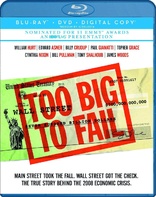Too Big to Fail Blu-ray Movie
HomeToo Big to Fail Blu-ray Movie 
Blu-ray + DVD + UV Digital CopyHBO | 2011 | 99 min | Rated TV-MA | Jun 12, 2012
Movie rating
6.7 | / 10 |
Blu-ray rating
| Users | 0.0 | |
| Reviewer | 4.0 | |
| Overall | 4.0 |
Overview
Too Big to Fail (2011)
The film chronicles the financial meltdown of 2008 and centers on the efforts of Treasury Secretary Henry Paulson and Federal Reserve Chairman Ben Bernanke to save the system from imminent collapse.
Starring: William Hurt, Paul Giamatti, James Woods, Billy Crudup, Cynthia NixonDirector: Curtis Hanson
| History | Uncertain |
| Drama | Uncertain |
Specifications
Video
Video codec: MPEG-4 AVC
Video resolution: 1080p
Aspect ratio: 1.78:1
Original aspect ratio: 1.78:1
Audio
English: DTS-HD Master Audio 5.1
French: DTS 5.1
Spanish: DTS 2.0
Subtitles
English SDH, French, Spanish
Discs
25GB Blu-ray Disc
Two-disc set (1 BD, 1 DVD)
UV digital copy
DVD copy
Packaging
Slipcover in original pressing
Playback
Region A, B (C untested)
Review
Rating summary
| Movie | 4.5 | |
| Video | 4.5 | |
| Audio | 3.5 | |
| Extras | 2.0 | |
| Overall | 4.0 |
Too Big to Fail Blu-ray Movie Review
Paulson Agonistes
Reviewed by Michael Reuben June 9, 2012When viewers pronounce HBO's docudrama Too Big to Fail "boring" (and I've heard this more than a few times), I have to wonder whether they'd be more interested if the desperate machinations depicted in the film had failed to stabilize the teetering economy. You may think high finance is dull, but I suspect your attitude would quickly change if you woke up one morning to find that your debit and credit cards didn't work, your bank accounts were frozen, your employer couldn't issue your paycheck (and if so, you couldn't cash it), and local stores, restaurants and other businesses were closing because they couldn't pay their vendors. At that point, I bet everyone would be intensely interested in how the hell this all happened. The irony of the events depicted in Too Big to Fail is that the urgent maneuvers by a small group of harried financiers and public employees succeeded just enough to avert the worst, thereby removing any incentive for the public to understand what had been accomplished—and also how fragile the system still is. For nearly four years since Sept. 2008, those events have been spun and sloganeered to such an extent that it's easy to forget how close we came to the edge of a financial cliff and how easily we could return there. One of the many virtues of Too Big to Fail is that it vividly recreates the uncertainty of those desperate hours, with their charged interplay and snap decisions. They've been second-guessed ever since; so why not try experiencing them with a "you are there" urgency? Too Big to Fail was adapted from the non-fiction book of the same name by journalist Andrew Ross Sorkin, who appears briefly in the film as a reporter covering the crisis. The script was written by Peter Gould, who is part of the cabal of twisted minds behind Breaking Bad. Indeed Gould's script reflects the same knack for juxtaposing the outlandish with the ordinary that characterizes AMC's groundbreaking show about a meth-dealing high school chemistry teacher. It's the perfect sensibility for portraying Wall Street's unique relationship with the rest of the world.
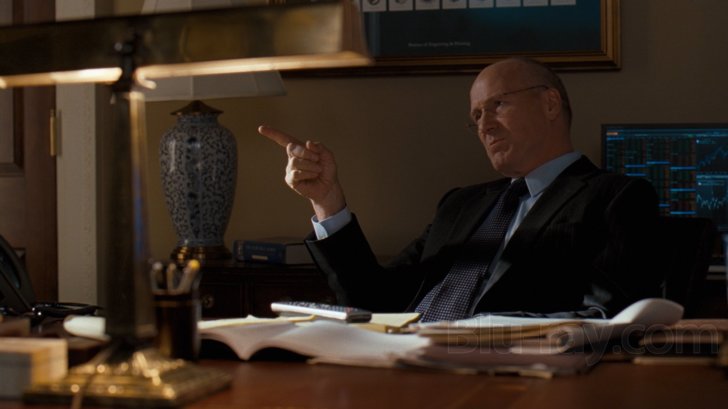
Director Curtis Hanson makes effective use of neatly edited footage from the major financial networks throughout Too Big to Fail. It's the equivalent of the spinning newspaper headline in old films, but here it supplies essential backgound information, including the run-up to the crisis. This included a twenty-year effort, supported by both major parties, to deregulate the financial industry, culminating in President Clinton's signature in 1998 of the repeal of Glass-Steagall, the Depression-era bill that separated commercial and investment banking. Commercial banks—those dull institutions that had done just fine for 60 years by taking in deposits, processing checks and making loans—were now free to go out into the markets and gamble. And gamble they did, in novel and complex ways that no one had ever imagined. One of the many virtues of Gould's script is the clarity with which some of the more baffling topics bandied about at the height of the crisis are explained through discussions among various characters grappling with the problem. Gould even figured out a way to explain "credit default swaps" that doesn't sound like gibberish. Too Big to Fail picks up the story in the late summer of 2008, after the failure earlier that year of Bear Sterns, which was the fifth largest investment bank. The real estate market had collapsed, contrary to the fairy tale on which investors and bankers alike had been resting their fortunes. The latest hope was that the damage could be confined to Bear Sterns (which had to be sold off in a fire sale to JP Morgan Chase with a $29 billion "sweetener" from the federal government). The smart money knew better, and short sellers (those betting that a stock will go down) expected Lehman Brothers, the fourth largest investment bank, to be the next to fall. Heavy short selling becomes a self-fulfilling prophecy, as other investors conclude that the "shorts" must know something and hastily unload their holdings. Lehman's CEO Dick Fuld (James Woods) is both furious and panicked as he watches his stock tank. The first half of Too Big to Fail follows the feverish efforts led by Treasury Secretary Hank Paulson (William Hurt) and his staff to save Lehman. Paulson has smart people helping him, including his future successor, Tim Geithner (Billy Crudup), who was then head of the New York Federal Reserve, and Geithner's boss, Ben Bernanke (Paul Giamatti, whose resemblance to the real Bernanke is eerie). But everything is stacked against him. Fuld cannot accept that Lehman, the institution he's spent his entire working life building, is so radically afflicted that most of it has to be cut loose. (His insistence that Lehman's junk real estate holdings still have value wrecks a potential deal with Korean investors.) Fuld's competitors—Jamie Dimon (Bill Pullman) at JP Morgan, Lloyd Blankfein (Evan Handler) at Goldman Sachs, John Mack (Tony Shalhoub) at Morgan Stanley, John Thain (Matthew Modine) at Merrill Lynch and Vikram Pandit (Ajay Mehta) at Citigroup—are in no hurry to bail him out. After all, he's the competition. Geithner and Paulson, himself a former head of Goldman Sachs, have to point out that they're all interconnected by a web of transactions. If one goes, they all go. As if the situation were not already sufficiently delicate, on Sept. 7, 2008, the deteriorating real estate market (and internal mismanagement) requires a government takeover of Fannie Mae and Freddie Mac, the two government-sponsored entities that, between them, hold or guarantee about half the mortgages in America. Fannie and Freddie have since become favorite scapegoats for the whole meltdown, but they're only pieces of the machinery. The immediate effect on the Lehman negotiations is to make Paulson even more reluctant to spend another dime of federal money to bail out Lehman. Over the weekend of Sept. 13, he summons the heads of the major banks to a meeting in New York and essentially threatens them into developing a workout for Lehman. "We will remember anyone who was not helpful", he tells them, with unmistakable menace. It's during this marathon weekend meeting that Paulson's team gets its first inkling of the problems at AIG. In effect, the insurance giant had "insured" all of the banks' mortgage-related assets, collecting millions in fees for doing so. What AIG had failed to do was set aside enough capital to pay off these "insurance" contracts if many borrowers defaulted and numerous claims came due at the same time—which was about to happen. (AIG, too, assumed that real estate values could only go up.) Once AIG defaulted, the banks would sustain losses of such magnitude that they'd go under. Lehman would not be the last to fail. As it turns out, Paulson's emergency session of major American banks did produce a deal to save Lehman Brothers. England's Barclays Bank was willing to buy it, along with a multi-billion dollar cash infusion contributed by the American institutions. There was just one problem: English regulators refused to approve the deal. The scene in which Paulson orders the SEC Commissioner, Christopher Cox (Peter Hermann), to direct Lehman to file Chapter 11, and Cox refuses, because he doesn't believe he has that authority, is well-documented and drama of the highest order. These were two of the top officials in the land at odds over a decision with global implications. In the end, Lehman did file on Monday, Sept. 15, 2008, and for a few hours all seemed well. Then the markets went into freefall. The second half of Too Big to Fail recounts the scramble by Paulson's team to devise a strategy to cage the beast they'd unwittingly unleashed, which ultimately led to the $700 billion Troubled Asset Relief Program or "TARP". In the film's account, TARP was essentially the product of three men: Paulson, who had become desperate; Bernanke, who, as a student of the Great Depression, believed that only a grand gesture, a "shock and awe" move, would be sufficient to stem the crisis; and Warren Buffett (Ed Asner), the famed investor who was Paulson's long-time friend and informal advisor. The scenes in which the Treasury team has to convince a reluctant Congress to approve TARP (not an easy task, as evidenced by the fact that it was voted down the first time) are dramatic and intriguing, but even better is the scene where Paulson summons the heads of every major bank to a meeting without telling them why. Then he walks in and tells them they'll accept billions of dollars in TARP money whether they want it or not. Many aren't pleased. But Paulson wasn't pleased either. As Too Big to Fail rolls toward its conclusion, William Hurt gives a masterful physical performance of a man who is being ripped apart inside by doing what his intellect tells him is necessary, even though it violates every core principle on which his life as a businessman has been founded. Here is a dyed-in-the-wool capitalist, who has spent most of his career trying to get government out of the financial industry. Now he has to force government back into the halls of banking as a partner and shareholder, even though the shares are non-voting. Paulson gets his way, but, as text screens at the film's close remind us, Bernanke's theory didn't fully pan out. The banks were supposed to lend out the TARP money and thereby get credit flowing again. Instead they held onto it and shored up their balance sheets. Still, the system stabilized to a degree, because markets run on confidence. The spectacle of the U.S. Treasury injecting billions into major financial institutions instilled confidence in the markets by reassuring all participants that the federal government would not allow the system to go under. (As Geithner tells Paulson, the Dow is up just because they're meeting.) These institutions were, indeed, too big to fail. This was not the message Hank Paulson wanted to send, but it ended up being the message he was forced to send.
Too Big to Fail Blu-ray Movie, Video Quality 
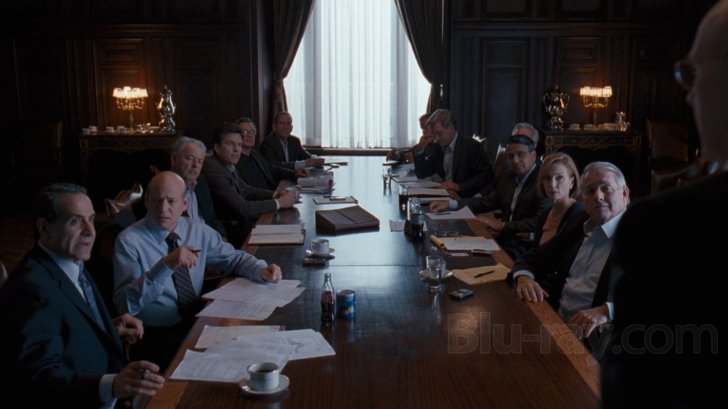
For a TV docudrama, digital photography might have seemed a natural fit, but director Hanson opted for traditional film, shot by Kramer Morgenthau, who has worked on Game of Thrones and Boardwalk Empire and also shot the underrated Fracture for Gregory Hoblit. Film was the right choice, because Hanson has adopted a kind of film noir style for Too Big to Fail, one that emphasizes a conspiratorial sense of secrecy, of a shadowy alternative world where the usual rules don't apply and dark deeds are brewing out of sight. Big conference rooms and large offices filled with shadows are ideal for establishing this atmosphere, and when Morgenthau provides a striking contrast (e.g., when we briefly flash to Warren Buffett in the Midwest getting ice cream with his granddaughters), it's like a reminder that there's a whole different world out there. HBO's 1080p, AVC-encoded Blu-ray provides a superior image, as one would expect from a contemporary production intended for HDTV broadcast. The image is clean, rich and colorful, with solid black levels (as shown by Dick Fuld's tuxedo, among other things), with excellent amounts of fine detail in faces, clothing and decor. The film grain is so fine as to be hardly noticeable, but this appears to be the result of proper lighting and careful post-processing, as opposed to any inappropriate digital manipulation. No artificial sharpening or compression artifacts were observed. This is a superior image all around.
Too Big to Fail Blu-ray Movie, Audio Quality 
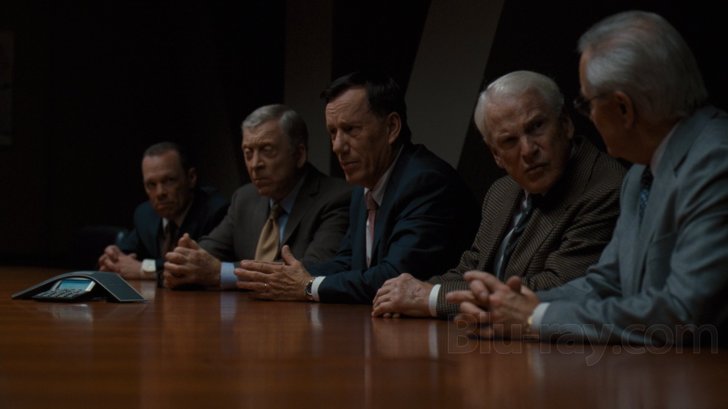
The DTS-HD MA 5.1 track isn't flashy, but it effectively mixes the cacophony of voices from both actors and journalists who participate by way of archival footage. Subtle ambient cues distinguish between boardooms and offices, on the one hand, and the occasional street scene where someone like Geithner or Blankfein may take a phone call. The unobtrusive score by Marcelo Zarvos (The Good Shepherd and Sin Nombre) is well represented.
Too Big to Fail Blu-ray Movie, Special Features and Extras 
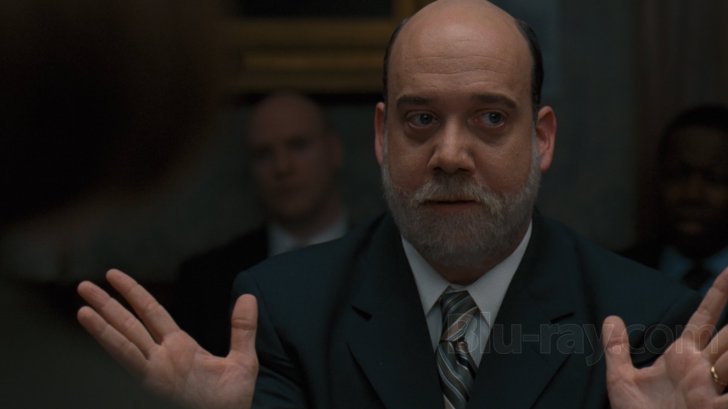
- The Making of Too Big to Fail (HD, 1080i; 1.78:1; 1:47): This is so brief that it's more a promo than a true "making of".
- Opening the Vault on the Financial Crisis (HD, 1080i; 1.78:1; 19:07): This featurette could accurately be titled "The Making of Too Big to Fail", although the participants aren't limited to the actors, screenwriter and director but also include journalists and economic experts. Among them are author Sorkin, journalists Joe Nocera, Bethany McLean, Fareed Zakaria and John Fund and economics professor Kenneth Rogoff.
- Timeline of a Crisis (HD, 1080p): A helpful graphical presentation of key dates and events during the concentrated period depicted in the film, beginning on Oct. 9, 2007, when the Dow Jones Industrial Average reached its highest point in history (14,164.53), and ending on Nov. 20, 2008, when it fell to its lowest point since 2003 (8046.62).
Too Big to Fail Blu-ray Movie, Overall Score and Recommendation 
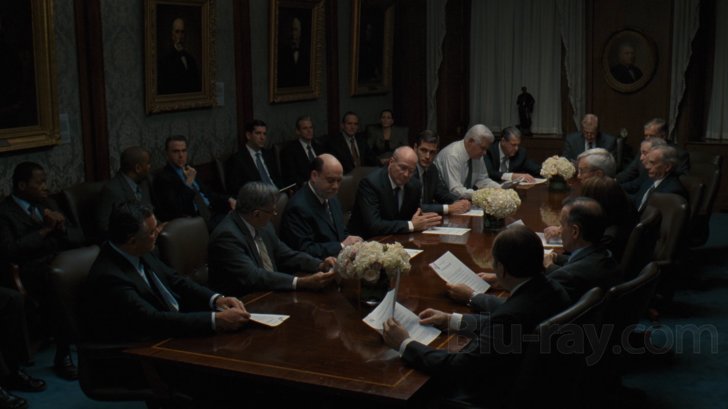
A question asked repeatedly and with increasing urgency during Too Big to Fail is: "Couldn't you see this coming?" The answer, of course, is yes. People did see it coming, but those who raised alarms were routinely shouted down, laughed at or ignored. The reason why is the same one Hank Paulson gives when his staff asks why these activities weren't better regulated: Everyone was making too much money (and not just the people on Wall Street). It's really that simple, but no one in a position of authority wants to come out and say it in public. Paulson's chief of staff, Jim Wilkinson (Topher Grace), tell the Assistant Secretary for Public Affairs, Michele Davis (Cynthia Nixon), to work on a way to say it better. They're still working on it. Highly recommended.
Similar titles
Similar titles you might also like

Quiz Show
1994

Suffragette
2015

World Trade Center 4K
2006

Darkest Hour 4K
2017

Bridge of Spies
2015

Munich
2005

Anonymous
2011

Colonia
2015

Selma
2014

Made in Dagenham
2010

Thirteen Days
2000

Chernobyl 4K
2019

Backstabbing for Beginners
2018

Good Night, and Good Luck.
2005

The Command
2018

Free State of Jones
2016

Invictus
2009

Killing Kennedy
2013

The Promise
2016

The Last Duel 4K
2021
